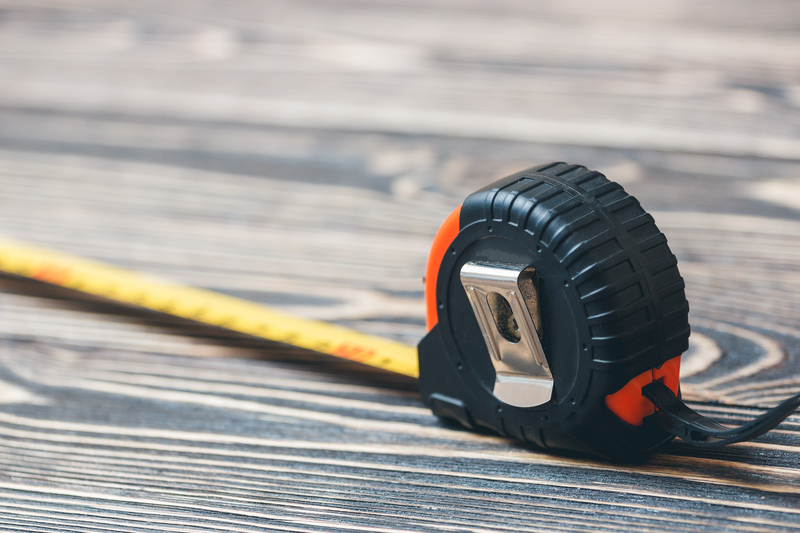The Ultimate Guide to Moving Your Bed and Mattress
Posted on 11/06/2025
The Ultimate Guide to Moving Your Bed and Mattress
Moving a bed and mattress can be one of the trickiest parts of any relocation. Whether you're changing homes, upgrading your furniture, or just rearranging your living space, properly moving a mattress and bed is crucial for convenience, health, and longevity of your bedding. This comprehensive guide provides everything you need to know--so your next move is a breeze, not a backache!
Why Proper Mattress and Bed Moving Techniques Matter
Your bed and mattress are more than just furniture--they're investments in your health and sleep quality. Moving a mattress incorrectly can cause damage, render your warranty void, or even lead to injury. Likewise, a bed that's not properly disassembled or handled may suffer structural damage. By learning correct moving techniques, you protect your belongings and ensure a restful night's sleep in your new space.
- Protect your investment by avoiding rips, tears, or bending
- Reduce injury risk to yourself and anyone helping you move
- Ensure hygiene--proper moving techniques keep your mattress clean
- Prevent bed frame damage for greater longevity

Step 1: Gather the Right Supplies
Successfully moving your bed and mattress starts with gathering all necessary supplies. Having the right moving tools makes the process smoother, safer, and much more efficient. Don't cut corners here--improper tools can lead to costly mistakes.
Essential Supplies List
- Mattress bag or plastic wrap: To keep your mattress clean and protected from dirt, water, and tears.
- Furniture blankets: For extra cushioning and protection, especially for headboards and footboards.
- Dolly or hand truck: To make transportation easier and safer on your back.
- Moving straps: For securing the mattress or bed parts during lifting and in the moving van.
- Tool kit (screwdriver, wrench, Allen key): For disassembling the bed frame and securing hardware in a bag.
- Tape and markers: For labeling and organizing screws and parts.
- Rope or bungee cords: To secure items during transport.
Step 2: Preparing Your Mattress for Moving
Mattresses are bulky and awkward to carry but are also susceptible to damage and contamination. Preparation is key when moving your mattress--here's how to do it right:
Clean and Inspect the Mattress
- Vacuum the entire surface to remove dust, dirt, or allergens.
- Spot-clean any stains with a mild upholstery cleaner.
- Allow it to fully dry before wrapping to prevent mildew and odors.
Wrap Your Mattress
- Use a mattress bag for complete protection. These are inexpensive and available at most moving or bedding stores.
- If a mattress bag isn't available, use plastic sheeting and packing tape. Make sure all sides of the mattress are covered and sealed, especially if it's raining or snowing on moving day.
- Label your mattress if you're moving several beds to avoid mix-ups.
Pro Tip: Always move your mattress upright to prevent it from bending unnecessarily, which can damage the inner structure or coils and void warranties.
Step 3: Disassembling Your Bed Frame
Most beds are designed for easy assembly and disassembly. Still, knowing the right steps will save you time and frustration during your move.
General Bed Frame Moving Tips
- Remove all bedding--pillows, sheets, and blankets should be packed separately in clearly labeled bags.
- Detach the headboard and footboard by unscrewing fasteners. Use the proper tool to avoid stripping screws.
- Take apart slats, rails, and center supports as necessary. Keep all hardware (nuts, bolts, screws) in a zip-top bag taped to a large bed component for easy reassembly.
- For adjustable or platform beds, refer to the manufacturer's manual for safe disassembly procedures.
Keep instructions close! If you still have the original assembly manual, keep it handy for reassembly in your new home.
Step 4: Safe Mattress and Bed Transport
How you carry and transport your bed and mattress makes a world of difference. Improper handling can lead to physical injury and damage the mattress or bed frame. Follow these safety-focused steps:
Lifting and Carrying Techniques
- Always lift with your legs, not your back.
- Use a moving buddy; mattresses and large bed frames are rarely safe for one person to carry alone.
- For stairs or tight spaces, plan your route in advance and remove tripping hazards.
Transporting Your Mattress
- Keep the mattress upright in the moving vehicle to avoid bending or folding.
- Secure it with ropes, bungee cords, or straps to prevent sliding.
- Never strap a mattress to the roof of your car--it's both unsafe and likely to damage the mattress beyond repair.
Moving the Bed Frame and Parts
- Wrap wooden or metal pieces with furniture blankets to avoid scratches.
- Stack slats and rails flat in the truck, using padding between layers.
- Keep all hardware bags taped to a main piece so nothing gets lost during the move.
Step 5: Reassembling Your Bed and Mattress
Upon arrival in your new home, unloading is only half the battle. Properly assembling your bed and mattress is critical for both comfort and safety.
Setting Up the Bed Frame
- Lay out all parts in your new bedroom and make sure everything arrived in good order.
- Refer to the instruction manual or previous photos for guidance if needed.
- Start by assembling the base and support slats, making sure everything is tightened securely and nothing wobbles.
- Add the headboard and footboard as directed.
Positioning and Unwrapping the Mattress
- Carefully remove the protective plastic bag or wrapping.
- Inspect the mattress for any damage incurred during the move.
- Place the mattress evenly on the bed frame, making sure it's the correct orientation and not overhanging the sides.
Bonus Tip: Allow the mattress to air out for a few hours before adding sheets and bedding, especially if wrapped in plastic during the move.
Special Considerations for Different Bed and Mattress Types
Not every bed and mattress is created equal--various types require different handling and care during a move.
Moving a Foam, Latex, or Hybrid Mattress
- Never fold or bend these mattresses, as this can permanently damage the structure.
- Heavier than innerspring mattresses, so use extra moving help.
- Be especially careful with memory foam; it can tear or deform if dragged or mishandled.
Moving an Innerspring Mattress
- Do not drag, as the coils can shift and distort the support system.
- Handle gently--even though these are sturdier, the surface fabric tears easily.
Adjustable Beds and Bases
- Unplug and secure all electrical and mechanical components.
- Disassemble into the smallest sections possible to prevent damage.
- Keep remotes, cords, and instruction manuals together in a labeled bag.
Bunk Beds or Loft Beds
- Fully disassemble where possible to avoid wobbling and breakage.
- Keep ladder, guardrails, and small parts bagged and labeled.
Hiring Professionals vs. DIY Mattress and Bed Moving
Should you move your bed and mattress yourself or hire experienced movers? The answer depends on your unique situation, the size and complexity of your furniture, and your budget.
When to DIY
- Moving a single bed or mattress you can safely handle with help
- Short distances with minimal stairs or obstacles
- Access to all necessary tools and supplies
When to Hire Professionals
- Multiple or large beds, king-size mattresses, or heavy bed frames
- Long-distance moves where time and protection are critical
- Limited help or challenging layouts (e.g., multiple staircases)
- Mattresses with special care needs (e.g., adjustable or specialty luxury beds)
Professional movers have the expertise, equipment, and insurance to ensure your mattress and bed frame arrive in pristine condition, saving you time and sanity.
Storage Tips for Beds and Mattresses
If you need to store your mattress or bed, either short-term during a move or for months in a unit, follow these essential steps:
- Always use a mattress bag and ensure it's sealed against dust and moisture.
- Store the mattress flat--not on its side--to prevent misshaping.
- Keep bed frame components together, wrapped in blankets to avoid scratches.
- Choose a climate-controlled storage unit to avoid temperature and humidity extremes that encourage mold or warping.
Common Mistakes to Avoid When Moving a Bed and Mattress
- Bending or folding mattresses (unless specifically designed for it) which often voids the warranty.
- Leaving bedding on during the move--it attracts dirt, bugs, and moisture.
- Improper labeling of bed hardware, making reassembly frustrating.
- Skipping protective wrapping, exposing mattresses and frames to costly accidents.
- Trying to move heavy items alone, risking serious injury.

Frequently Asked Questions About Moving Beds and Mattresses
Can You Transport a Mattress on a Car Roof?
Experts strongly advise against this. Transporting mattresses on a car roof is unsafe, often illegal, and nearly always results in damage. Always use a proper moving truck or van.
What If My Mattress Won't Fit Through the Door?
Many mattresses are flexible enough to bend slightly (except for foam and some hybrids), but never force or excessively bend a mattress. Try alternative angles or remove doorframes for extra clearance. If all else fails, consider a split box spring or professional help.
Is It Worth Buying a Mattress Bag?
Absolutely-- these affordable covers protect against dirt, bugs, moisture, and rips. Never move or store a mattress without protective covering.
How Long Should You Keep a Mattress?
Industry standards suggest replacing your mattress every 7-10 years, depending on quality and use. If in doubt, check your mattress for sagging, stains, or odors before moving it--you might be better off replacing it rather than transporting a worn-out bed.
Conclusion: Moving Your Bed and Mattress the Right Way
Following the best practices for moving your bed and mattress will save you time, money, and plenty of headaches. With proper preparation, the right supplies, and careful technique, your move will go smoothly and your sleep setup will be in top condition for years to come. Whether you DIY or hire the professionals, treat your bed and mattress well--they deserve it, and so do you!
